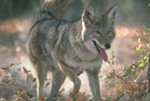
We ran into a bunch of coyotes while out walking this morning. The first time, I was walking up a hill to get onto the levee. The dogs were off leash. I looked up and saw a coyote looking at us from the levee. The dogs saw it at the same time and went after it. Daisy Mae came back immediately on calling her. Dog of Little Brain (Ahi) took longer to return. Luckily, she returned.
I waited for a friend and then we continued on the levee. After about 300 yards, we saw two more coyotes on the hill looking at us. They were probably 150 feet away from us. We put the dogs on leash and went the other way! We continued our walk in the safety of the neighborhood!
Here are some interesting facts about coyotes:
One of the keys to the coyote's success is its diet. A true scavenger, the coyote will eat just about anything. Identified as a killer of sheep, poultry and deer, the coyote will also eat snakes and foxes, doughnuts and sandwiches, rodents and rabbits, fruits and vegetables, birds, frogs, grass and grasshoppers, pet cats and cat food, pet dogs and dog food, carrion, and just plain garbage.
Coyotes are active mainly during the nighttime, but they can be moving at any time during the day. Most sightings of coyotes occur during the hours close to sunrise and sunset.
Adult coyotes weigh between 20 and 45 pounds. Females are generally smaller than males and western coyotes are generally smaller than eastern coyotes.
Coyotes look like small collie dogs. They have erect pointed ears, slender muzzle, and a bushy tail. Most coyotes are brownish gray in color with a light gray to cream-colored belly. However, a coyote's color varies and may be somewhat darker or lighter depending upon the geographic region and the time of year. Most coyotes have dark or black hairs over their back and tail.
A high reproductive rate and rapid growth of offspring aid in the coyote's success. Coyotes breed in February and March and pups are born about 60 days later. An average coyote litter contains four or five pups. Pups are born in dens. In urban environments, dens can be in storm drains, under storage sheds, in holes dug in vacant lots, parks, or golf courses, or any other dark, dry place.
Pups are cared for by both parents and can eat meat and move about well by the time they are a month old. Because food requirements increase dramatically during pup rearing, this is a period when conflicts between humans and urban coyotes are common. By 6 months of age, pups have permanent teeth and are nearly fully grown. About this time, mother coyotes train their offspring to search for food so it is not unusual to observe a family group traveling through parks and golf courses. If food is deliberately or inadvertently provided by people, the youngsters quickly learn not to fear humans and will develop a dependency on easy food sources.
After this training period, usually in October and November, most young disperse and find their own breeding territory, but one or two pups may stay with the parents and become part of the family group. Although coyotes tend to travel and hunt singly or in pairs, they may form groups as population densities increase or where food is abundant such as in urbanized areas.
In areas where they are hunted or trapped, coyotes are extremely wary of human beings. However, in urban areas where they are less likely to be harmed and more likely to associate people with an easy and dependable source for food, they can become very bold. They will come up to the door of a house if food is regularly present. Coyotes have learned that small dogs and cats are easy prey. Newspapers across the country have carried stories of coyotes harassing leashed dogs on walks with their owners in and near parks and golf courses within city limits.
No comments:
Post a Comment